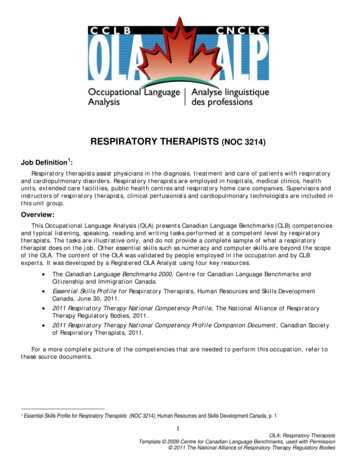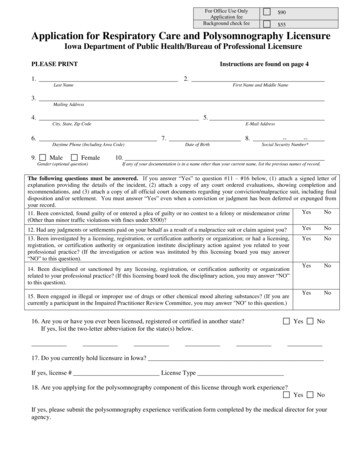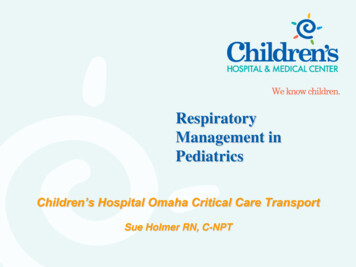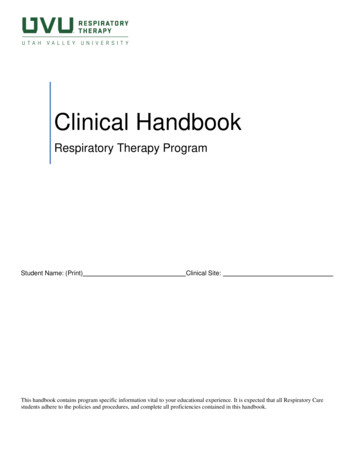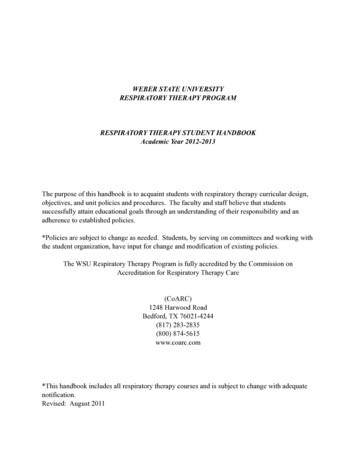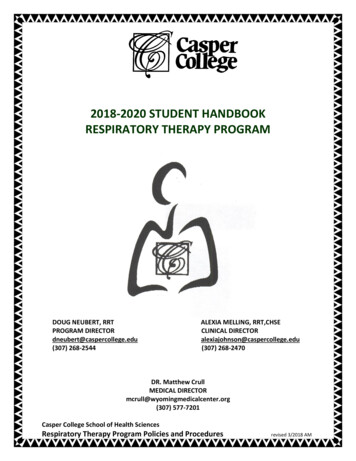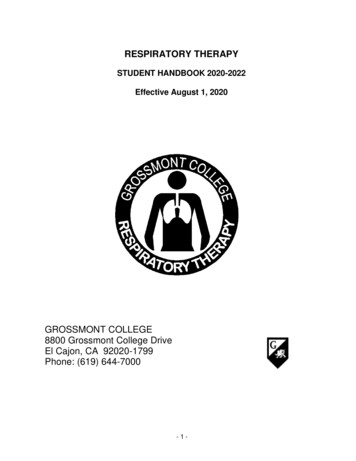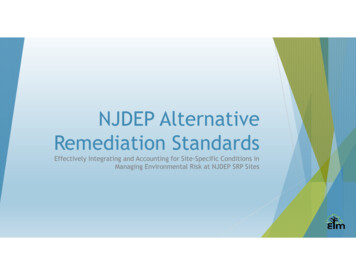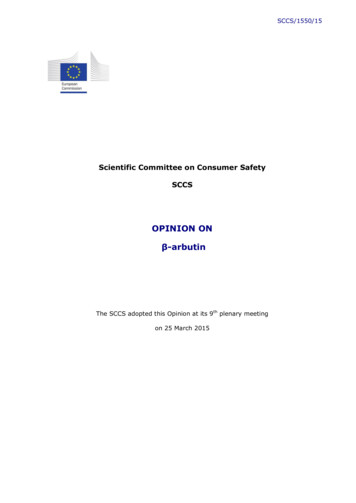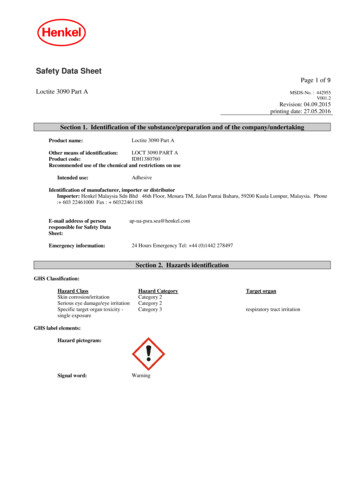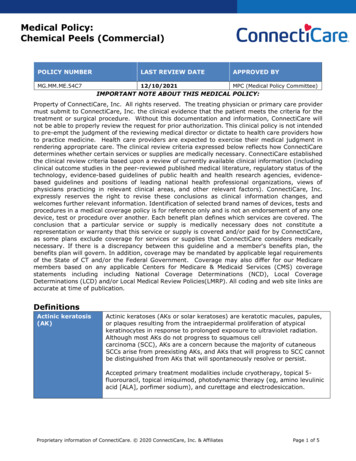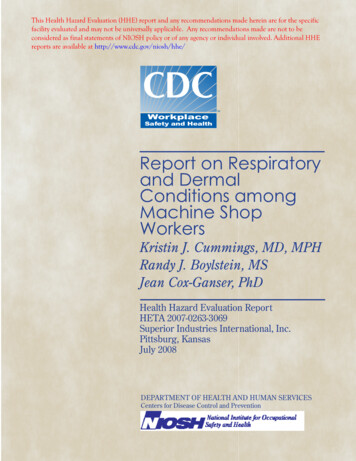
Transcription
This Health Hazard Evaluation (HHE) report and any recommendations made herein are for the specificfacility evaluated and may not be universally applicable. Any recommendations made are not to beconsidered as final statements of NIOSH policy or of any agency or individual involved. Additional HHEreports are available at http://www.cdc.gov/niosh/hhe/WorkplaceSafety and HealthReport on Respiratoryand DermalConditions amongMachine ShopWorkersKristin J. Cummings, MD, MPHRandy J. Boylstein, MSJean Cox-Ganser, PhDHealth Hazard Evaluation ReportHETA 2007-0263-3069Superior Industries International, Inc.Pittsburg, KansasJuly 2008DEPARTMENT OF HEALTH AND HUMAN SERVICESCenters for Disease Control and Prevention
The employer shall post a copy of this reportfor a period of 30 calendar days at or nearthe workplace(s) of affected employees. Theemployer shall take steps to insure that theposted determinations are not altered, defaced,or covered by other material during suchperiod. [37 FR 23640, November 7, 1972, asamended at 45 FR 2653, January 14, 1980].
ContentsReportAbbreviations. iiHighlights of the NIOSH Health Hazard Evaluation. clusions.9Recommendations.11References.14Appendix AEnvironmental Monitoring Data.16Appendix BP&K Culture and Endotoxin Analyses.30Appendix CNIOSH Glucan Analyses.41Appendix DMiL, Inc. PCR Analyses.42AcknowledgmentsAcknowledgements and Availability of Report.52Health Hazard Evaluation Report 2007-0263Page i
WAPCRLALPage iiCenters for Disease Control and PreventionComputer numerical controlDeoxyribonucleic acidHealth Hazard Evaluationlitersmilligrams per cubic meter of airmetalworking fluidNational Institute for Occupational Safety and HealthOccupational Safety and Health Administrationpermissible exposure limitrecommended exposure limittime-weighted averagepolymerase chain reactionLimulus amoebocyte lysateHealth Hazard Evaluation Report 2007-0263-3069
Highlights of theNIOSH HealthHazard EvaluationWhat NIOSH Did: Conducted telephone interviews with workers, companymanagement and safety officials, treating physicians, and thedirector of the company’s referral occupational health clinic Reviewed medical records Reviewed records of MWF and air monitoring conducted bythe company Tested samples of MWF collected in the machine shopNIOSH received aconfidential request toconduct a health hazardevaluation at SuperiorIndustries International,Inc. in Pittsburg, Kansas.Workers reportedrespiratory and skinproblems that they relatedto the metalworking fluid(MWF), or coolant, used inthe machine shop.What NIOSH Found: Some workers in the machine shop have had work-relatedrespiratory and skin problems that have been shown in thescientific literature to be associated with exposure to MWF Workers are hesitant to share health and safety concerns withmanagement Workers reported not receiving training on the health risksassociated with exposure to MWF Culture tests showed MWF had no or low growth of bacteria,fungi, and mycobacteria Additional non-culture tests showed MWF containedproducts of fungi and mycobacteria, specificallyMycobacterium immunogenum Ventilation in the machine shop is limited to general exhaust Workers in the machine shop are not in the facility’srespiratory protection program Workers in the machine shop can be seen at the referraloccupational health clinic, but are not in a medicalsurveillance programWhat Superior Industries InternationalManagers Can Do: Foster open communication with workers about health andsafety issues Provide workers with training on MWF, includinginformation on symptoms associated with exposure to MWF Continue air monitoring and include personal samplingHealth Hazard Evaluation Report 2007-0263-3069Page iii
Highlights of theNIOSH HealthHazard Evalution(continued) Continue monitoring the in-use MWF Add local exhaust ventilation to machines using MWF Include machine shop workers in the company’s respiratoryprotection program Provide protective clothing including gloves to all workerswho have skin contact with MWFNIOSH found thatworkers in the machineshop have respiratoryand skin exposure toMWF. Exposure to MWFhas been shown inthe scientific literatureto be associated withrespiratory and skinconditions. NIOSHrecommends thatmanagement reduceworkers’ exposure toMWF by installing localventilation and providingworkers with personalprotective equipment,including respirators andgloves.Page iv Establish a medical surveillance program for workers exposedto MWFWhat Superior Industries International WorkersCan Do: Use personal protective equipment such as respirators andgloves Participate in a medical surveillance program Report respiratory and skin problems to safety officials andthe referral occupational health clinicHealth Hazard Evaluation Report 2007-0263-3069
SummaryOn May 25, 2007, NIOSHreceived a confidentialHHE request fromworkers at SuperiorIndustries International,Inc. in Pittsburg, Kansas.Workers reportedrespiratory and skinproblems that they relatedto the metalworking fluid(MWF), or coolant, usedin the machine shop.The NIOSH investigationfound that workers inthe machine shop haverespiratory and dermalexposure to MWF andsymptoms consistentwith that exposure.NIOSH recommends thatmanagement providetraining on MWF toexposed workers, conductenvironmental monitoringthat includes personalsampling, implementlocal ventilation, providepersonal protectiveequipment includingrespirators and gloves,and establish a medicalsurveillance program.On May 25, 2007, the National Institute for OccupationalSafety and Health (NIOSH) received a confidential HealthHazard Evaluation (HHE) request from workers at the SuperiorIndustries International, Inc. facility in Pittsburg, Kansas. Workersreported recurrent pneumonias, asthma, and other respiratorysymptoms as well as rashes and skin irritation that they related tothe metalworking fluid (MWF), or coolant, used in the facility’smachine shop. Exposure to MWF is associated with respiratoryconditions, including asthma, bronchitis, and hypersensitivitypneumonitis, as well as with dermatitis [NIOSH 1998]. NIOSHhas established a Recommended Exposure Limit (REL) for MWFin the air of 0.4 mg/m3 (thoracic particulate mass), as a timeweighted average [TWA] for up 10 hours. This level corresponds to0.5 mg/m3 for total particulate mass.NIOSH investigators conducted telephone interviews with workers,treating physicians, company management and safety officials, andthe director of the company’s referral occupational health clinic.They reviewed medical records and environmental monitoringconducted by the company. They also conducted microbiologicaltests on samples of MWF collected from the machine shop.The investigators found that workers’ symptoms and diagnoseswere consistent with those associated with exposure to MWF.Workers in the machine shop reported not receiving training onthe health hazards of MWF and not being provided respiratoryprotection; furthermore, they are not in a medical surveillanceprogram. Operations are enclosed, but ventilation is limited togeneral exhaust and workers handling the automobile wheels haveskin contact with MWF. Environmental monitoring conducted bythe company showed MWF air levels above the NIOSH REL, butno or low growth of bacteria and fungi in the MWF. Analyses ofMWF by NIOSH confirmed the minimal microbial growth, butdid demonstrate the presence of mycobacterial DNA and fungalproducts.NIOSH recommends that management provide training onMWF to exposed workers, conduct environmental monitoringthat includes personal sampling, implement local ventilation,provide personal protective equipment including respirators andgloves, and establish a medical surveillance program aimed at earlyidentification of MWF-related respiratory and dermal conditions.Keywords: metalworking fluid, occupational asthma, hypersensitivitypneumonitis, dermatitis, mycobacteriaHealth Hazard Evaluation Report 2007-0263-3069Page v
IntroductionOn May 25, 2007, the National Institute for Occupational Safetyand Health (NIOSH) received a confidential Health HazardEvaluation (HHE) request from workers at Superior IndustriesInternational, Inc. in Pittsburg, Kansas. The requesters describedrecurrent pneumonias, asthma, and other respiratory symptomsas well as rashes and skin irritation among workers in the facility’smachine shop. They expressed concern about respiratory and skinexposures to the metalworking fluid (MWF), or coolant, used inthe machine shop.Occupational exposure to MWF is associated with respiratoryillnesses including lipid pneumonia, legionellosis, hypersensitivitypneumonitis, asthma, and chronic bronchitis [NIOSH, 1998].Lipid pneumonia and legionellosis have been reported rarelyin recent decades. However, hypersensitivity pneumonitis, anallergic pneumonia, has been the subject of more recent reportsof workers exposed to MWF [CDC 1996; Kreiss, Cox-Ganser1997; Freeman et al. 1998; Zacharisen et al. 1998; Fox et al. 1999;Shelton et al. 1999; Hodgson et al. 2001; CDC 2002; Bracker et al.2003; Trout et al. 2003; Beckett et al. 2005; Dawkins et al. 2006;Gupta, Rosenman 2006; Robertson et al. 2007]. In some recentinvestigations of outbreaks of MWF-associated hypersensitivitypneumonitis, other respiratory illnesses, including asthmaand chronic bronchitis, have been found in co-workers [Kreiss,Cox-Ganser 1997; Zacharisen et al. 1998; Hodgson et al. 2001;Robertson et al. 2007].It is not certain which components or contaminants of MWF areresponsible for the development of respiratory illness in exposedworkers. For hypersensitivity pneumonitis, evidence points toorganisms that grow in MWF, such as bacteria, mycobacteria,and fungi [Kreiss, Cox-Ganser 1997; NIOSH 1998; Fox et al.1999; Shelton et al. 1999; CDC 2002; Beckett et al. 2005;Robertson et al. 2007]. When inhaled, these organisms or theirproducts may cause an allergic response in the lungs of someworkers. Organisms have typically been identified through theirgrowth in culture, although allergic sensitization to bacteria isindependent of their culturability [Veillette et al. 2004]. In arecent investigation of 19 cases of hypersensitivity pneumonitisat a manufacturing facility, bacteria did not grow in the facility’sMWF, but an association was found between illness and bacterialgenetic material (deoxyribonucleic acid, or DNA) detected in thefacility’s MWF [Robertson et al. 2007]. For asthma, which maybe irritant or allergic, evidence points to organisms, as well as toHealth Hazard Evaluation Report 2007-0263-3069Page 1
Introduction (continued)MWF components and additives or by-products, including amines,chlorine, and formaldehyde [NIOSH 1998].NIOSH recommends keeping the concentration of MWF in theair to 0.4 mg/m3 (thoracic particulate mass), as time-weightedaverage (TWA) for up 10 hours, corresponding to 0.5 mg/m3for total particulate mass [NIOSH 1998]. This recommendedexposure limit (REL) reduces, but does not eliminate, respiratoryillnesses associated with MWF, as some workers have developedhypersensitivity pneumonitis and asthma when exposed to MWFat lower concentrations [NIOSH 1998]. Because respiratory illnesscan develop even at levels below the REL, medical monitoring ofworkers exposed to MWF is recommended [NIOSH 1998; OSHA1999; Cohen, White 2006].Workers with exposure to MWF are also at risk for skin conditions[NIOSH 1998]. Components and contaminants of MWF maycause irritant contact dermatitis or allergic contact dermatitis.Reducing skin exposure to MWF is essential to preventing MWFassociated dermatitis [NIOSH 1998; OSHA 1999].Process DescriptionSuperior Industries International, Inc. supplies cast andforged aluminum road wheels for the original equipmentautomotive industry. The facility in Pittsburg, Kansas is one ofnine manufacturing facilities operated by Superior IndustriesInternational, Inc. in the United States, Mexico, and Europe. Inaddition to the machine shop, the facility includes a foundry,where an aluminum alloy is melted and cast, and a coating shop,where wheels are painted and clear coated. The company is aparticipant in the OSHA Voluntary Protection Program.The machine shop consists of 29 lines where computer numericalcontrol (CNC) lathes and drilling machines are used to shapethe wheels. Wheels are loaded and unloaded by robots and theautomated machining operations are enclosed. After automatedmachining, workers deburr the wheels by hand. Ventilation in themachine shop consists of a general exhaust system with 17 exhaustfans. Individual machines do not have local exhaust systems. Atthe time of the investigation, the machine shop operated 24 hoursper day, with two 12-hour shifts. There were approximately 100workers in the machine shop, divided between the two shifts.Workers in the machine shop are not in a respiratory protectionprogram.Page 2Health Hazard Evaluation Report 2007-0263-3069
Introduction (continued)Each machine has an individual MWF reservoir that is connectedto a common system, with the exception of one machine (29),which has its own sump not connected to the common system.MWF is used as a lubricant and coolant during the automatedmachining and as a means of collecting pieces of aluminum cutfrom the wheels. Such pieces are carried via canals (“sharks”)under the machine shop to a filtration area, the chip recoverysystem (labeled “premelt” in Appendices B, C, and D), where thealuminum is recovered. The canals are visible through overlyinggrating in the machine shop floor. The capacity of the system isapproximately 70,000 gallons. Since 2004, the facility has beenusing a soluble mineral oil MWF that is promoted as minimizingmicrobial growth and the need for the addition of biocides.The facility monitors the in-use MWF to evaluate the performancecharacteristics of the MWF. The facility provides a sample to themanufacturer weekly and receives a report that includes MWFconcentration, pH, chloride concentration, and bacterial andfungal counts as well as recommendations for MWF management.The amount of bacteria and fungi in the sample is determinedby using dip slides with bacterial growth agar on one side andfungal growth agar on the other. The dip slide is coated with theMWF sample and incubated for several days, after which countsare determined from a colorimetric assay. The dip slide tests arenot designed to identify mycobacteria or other bacteria and fungithat require unusual growth factors or prolonged incubation.Since the introduction of this MWF at the facility in 2004, themanufacturer has made recommendations to add MWF but hasnot recommended addition of biocides or change-out of the MWF.The facility most recently monitored the air in the machine shop in2004 and 2006. This monitoring was conducted by the corporateindustrial hygienist. Analysis was conducted for oil mist, metalsincluding aluminum, and several organic compounds.Health Hazard Evaluation Report 2007-0263-3069Page 3
AssessmentA physician, industrial hygienist, and epidemiologist from theNIOSH Division of Respiratory Disease Studies conducted theinvestigation. The investigators interviewed workers, companymanagement and safety officials, and treating physicians bytelephone to assess the machine shop layout, work processes,potential exposures, and health problems encountered by workers.They reviewed results from MWF and air monitoring conductedby the company. They also communicated with investigatorsconducting a concurrent Occupational Safety and HealthAdministration (OSHA) inspection of the facility; identifyingworker information was not shared with OSHA. The investigatorsdiscussed medical surveillance of workers with the director of theoccupational health clinic at Mt. Carmel Regional Medical Center,which was identified by company safety officials as the facility’sreferral occupational health clinic.The NIOSH investigation included tests on MWF collected atthe facility to assess for the presence of microbes, such as bacteriaand fungi. Two types of tests were conducted: those that detectorganisms by seeing if they grow under laboratory conditions(culture tests) and those that detect organisms by seeing if someunique material made by the organism is present (non-culturetests). On June 28, 2007, samples were collected for NIOSH bya resident physician rotating at NIOSH, with the assistance ofcompany representatives. On November 28, 2007, additionalsamples were collected for NIOSH by an OSHA industrialhygienist conducting a concurrent inspection of the facility. Onboth occasions, samples were collected from the following machineshop locations: the reservoirs of machines (lathes) 1, 8, 13, 20, 25,26, 27, 28, and 29; the east and west sharks; and the chip recoverysystem (labeled “premelt” in Appendices B, C, and D). Thesamples were shipped overnight directly to the laboratories andchain of custody was followed.The samples collected on June 28, 2007, were analyzed by culturefor bacteria, mycobacteria (a special type of bacteria), and fungiby EMLab P&K, a commercial laboratory. If organisms grewin culture, speciation techniques were used to determine whichspecies were present. Details on the culture media, incubationtemperature, and incubation times used for the cultures arecontained in Appendix B. EMLab P&K also conducted a nonculture test to determine the level of endotoxin, a compoundproduced by gram negative bacteria, in each sample. For this test,the lab used the Limulus amoebocyte lysate (LAL) chromogenicPage 4Health Hazard Evaluation Report 2007-0263-3069
Assessment (continued)kinetic assay. Information about the endotoxin test can be foundin Appendix B. In addition to these tests, NIOSH laboratoryspecialists conducted a non-culture test to determine the level of(1 3)-β-D-glucan (“glucan”), a cell wall component of fungi, usinga glucan-specific LAL assay. The glucan-specific LAL assay allowsmeasurement of glucan without interference from endotoxin.Endotoxin indicates the presence of gram negative bacteria andglucan indicates the presence of fungi, even if the organismsthemselves do not grow in culture.The samples collected on November 28, 2007, were analyzedfor mycobacterial DNA using polymerase chain reaction(PCR) amplification by Microbe Inotech Laboratories (MiL),Inc., a commercial laboratory. DNA is the genetic material ofmycobacteria. If mycobacterial DNA was detected, further tests(melt curves) were used to determine which species were present.Details on the PCR techniques and melt curves are contained inAppendix D. PCR can detect the presence of mycobacterial DNA,even if the mycobacteria themselves cannot be cultured.Health Hazard Evaluation Report 2007-0263-3069Page 5
ResultsNIOSH investigators interviewed six machine shop workers bytelephone. Workers described a “haze” or “fog” of MWF that iscontinuously visible in the machine shop, but worse in wintermonths when less outdoor air is introduced. They indicated thatskin and clothing contact with MWF occurs during deburring andother machine shop tasks.Five of the workers described one or more respiratory symptoms,including cough, wheeze, chest tightness, chest discomfort, andshortness of breath, that get better when away from the machineshop. Two workers have been diagnosed by a pulmonologist withoccupational asthma.One worker experienced recurrent pneumonias. In one episode,after time away from the machine shop, this worker experiencedchest discomfort, cough, and shortness of breath that began 4-5hours into a shift. These symptoms were followed by fever, chills,and sweats. This constellation of symptoms was concerning to theworker’s pulmonologist for hypersensitivity pneumonitis.Four of the workers described skin irritation and rash that getbetter when away from the machine shop or when they usepersonal protective equipment that reduces skin contact withMWF, such as gloves and aprons. Several workers also describedwork-related eye irritation and nasal symptoms.Workers described a lack of trust in the management and safetyofficials at the facility with regard to health and safety issues. Theyreported receiving no training on the symptoms and illnessesassociated with occupational exposure to MWF. Workers who didask questions of safety officials about health risks described beingprovided with misinformation.The company’s lack of open communication about possible healtheffects of MWF exposure has contributed to a climate of suspicionamong machine shop workers. In the absence of accurateinformation, workers have turned to speculation about changesto the concentration of the fluid, addition of biocides or otherchemicals, overgrowth of bacteria, and activities that occur duringthe annual facility shut-down.Records of MWF monitoring conducted by the facility and MWFmanufacturer on a weekly basis from May 2004 through June2007 demonstrate that the MWF concentration varied from 3.7%Page 6Health Hazard Evaluation Report 2007-0263-3069
Results (continued)(on January 18, 2006) to 11.3% (on January 23, 2007) (AppendixA). Most readings fell in the range of 7-9%, close to the 8%recommended by the MWF manufacturer. The pH during thisperiod varied little, staying close to 9.0. These records also showno or low growth of bacteria and no growth of fungi.Records of air monitoring show that sampling was conductedon January 29, 2004 and October 31, 2006 (Appendix A). Therecords do not indicate where in the facility the samples weretaken. The corporate industrial hygienist reported that sampleswere collected using NIOSH sampling protocols over 8 hours. The2004 samples had oil mist concentrations of 1.133 mg/m3 and 0.11 mg/m3. The 2006 samples had oil mist concentrations of0.802 mg/m3 and 0.653 mg/m3. While all samples were below theOSHA permissible exposure limit (PEL) of 5 mg/m3 , all samplesbut one were in excess of the NIOSH REL.None of the 12 samples of MWF collected for the NIOSH HHEon June 28, 2007, grew mycobacteria or fungi (Appendix B). Eachsample grew bacteria, ranging from 200 colony forming units permilliliter (CFU/ml) (2 colonies) from the machine 29 sample to2700 CFU/ml (27 colonies) from the east shark sample. Theseconcentrations represent very low concentrations of bacteria.Bacteria included Bacillus species (generally gram-positiveorganisms), other gram-positive bacilli, and gram-positive cocci.Most of the bacteria that were cultured are commonly found in soiland/or on human skin. None of the bacteria that were culturedtypically causes infection in humans under normal conditions,although some may occasionally cause infection in persons withweakened immune systems or under unusual circumstances, suchas in the setting of traumatic injury. Bacillus cereus can causetoxin-mediated food poisoning if food on which it is growing isingested.Endotoxin levels ranged from 52 endotoxin units per milliliter(EU/ml) in machine 29 sample to 150 EU/ml in the samplestaken from machines 8 and 26, the east and west sharks, andthe premelt (Appendix B). These endotoxin levels are very low,consistent with the lack of growth of gram-negative bacteria in thecultures. Eleven of the samples were positive for the presence ofglucan; the machine 29 sample was negative for glucan (AppendixC). The average glucan level in the 11 positive samples was 185.0ng/ml, with a range of 133.8 to 266.1 ng/ml. These glucan levelsHealth Hazard Evaluation Report 2007-0263-3069Page 7
Results (continued)indicate the presence of fungi in the MWF.Of the 12 samples collected on November 28, 2007, 11 werepositive for the presence of mycobacterial DNA, specificallyMycobacterium immunogenum (Appendix D). The machine 29sample was negative for mycobacterial DNA. Mycobacteriumimmunogenum, a rare species of mycobacteria related toMycobacterium chelonae, has been found in MWF in someinvestigations of work-related hypersensitivity pneumonitis [Kreiss,Cox-Ganser 1997; Fox et al 1999; Shelton et al. 1999; Wilson et al2001; Trout et al 2003; Beckett 2005; Gupta, Rosenman 2006].Page 8Health Hazard Evaluation Report 2007-0263-3069
ConclusionsOccupational exposure to MWF is known to be associated withrespiratory illnesses and skin problems. It is not certain whichcompounds in MWF are responsible. Possible causes includeexposure to MWF components, additives, by-products, andmicrobes, such as bacteria, mycobacteria, and fungi. In the absenceof certainty about the cause of symptoms and the nature of thedose-response relationship, reducing workers’ exposure to MWFthrough engineering controls and personal protective equipmentis necessary. Both NIOSH and OSHA provide guidelines forreducing workers’ exposure to MWF [NIOSH 1998; OSHA1999]. Furthermore, because respiratory disease has occurred withexposures below the NIOSH REL, ongoing monitoring of workersfor symptoms is prudent [NIOSH 1998; OSHA 1999].Workers in the machine shop at the Superior IndustriesInternational, Inc. facility in Pittsburg, Kansas have had workrelated respiratory and skin problems consistent with thoseassociated with exposure to MWF. Management has beenproactive about conducting routine monitoring of in-use MWF todetect, among other things, gross overgrowth of bacteria and fungi.The lack of growth on these tests is an encouraging outcome thatreflects good MWF maintenance practices. However, these resultsdo not represent an exhaustive microbial characterization of thein-use MWF in the machine shop and should not be interpreted tomean that no MWF-related health risk exists. A study comparingculture to the direct count method showed that the culture methodidentified less than 1% of the microbial mass present in MWF[Veillett et al. 2004].The detectable glucan and mycobacterial DNA indicate that bothfungal and mycobacterial products were present in the in-useMWF. This finding suggests that viable fungi and mycobacteriamay have been present in the past and may be currently presentin the in-use MWF, despite the lack of growth of these organismsby culture tests. Regardless of the original source of organisms,once they have become established in a MWF system, it is difficultto eliminate such organisms by changing the MWF [Veilletteet al. 2004]. Adding biocides in attempt to eliminate suchorganisms may expose workers to additional health risks relatedto the biocides themselves [NIOSH 1998]. Thus the reduction ofexposures through engineering controls and personal protectiveequipment should be emphasized. Currently in the machineshop, ventilation is limited to general exhaust and workers are notprovided with respiratory protection.Health Hazard Evaluation Report 2007-0263-3069Page 9
Conclusions(continued)Open communication with workers about the health risksassociated with exposure to MWF and training on the ways toreduce risk is recommended by both NIOSH and OSHA [NIOSH1998; OSHA 1999]. Workers in the machine shop reported thatthey do not receive training on the health risks associated withexposure to MWF and that they are hesitant to share health andsafety concerns with management. Workers who have sharedconcerns described receiving inaccurate information frommanagement and safety officials.The best evidence that MWF exposures are being controlledmay be that workers do not experience MWF-related symptoms.However, even if most workers experience improvement in theirsymptoms after controls are instituted, and new workers remainfree of symptoms, some workers with allergic conditions maynot show improvement. Because their immune systems maycontinue to react to very small amounts of substances to whichthey are allergic, such individuals may have to avoid exposure toMWF even after otherwise successful controls are introduced. Anindividualized management plan (such as assigning an affectedworker to a different work location) is sometimes required,depending upon medical findings and recommendations of theindividual’s physician.Page 10Health Hazard Evaluation Report 2007-0263-3069
Recommendations1) Communication and Training:Foster open communication among management, safety officials,and workers about the health risks of MWF. Training about MWFshould include accurate information about the adverse healtheffects associated with exposure to MWF and how exposure canbe reduced. Training about MWF should be provided at the timeof initial job assignment, to current workers who have not beenpreviously trained, whenever a new and significantly differentMWF is introduced, and whenever a new way of protectingworkers is introduced [OSHA 1999]. Details on designing a MWFtraining program can be found in the OSHA MWF Best Practicesmanual workingfluids manual.html#f).2) Environmental Monitoring:Continue to conduct monitoring of air and in-use MWF. The goalof air monitoring is to ensure a more healthful work environmentwhere worker exposures do not exceed the NIOSH REL. However,because adverse health effects can occur below the REL, lowerexposures are desirable whenever feasible. The initial air samplingsurvey should collect representative personal samples for t
Health Hazard Evaluation Report 2007-0263-3069. Page iii. H. gi H gl i H t s o f t H e. niosH H. e A l t H. H. A z A R d. e. v A l u A toi n. What NIOSH Did: Conducted telephone interviews with workers, company
